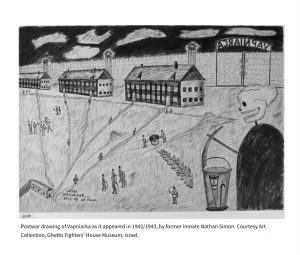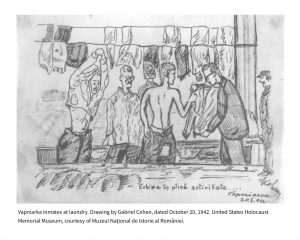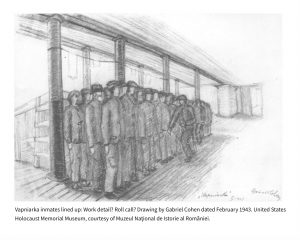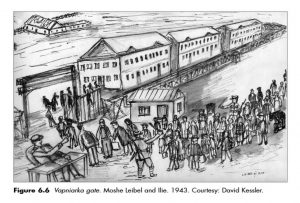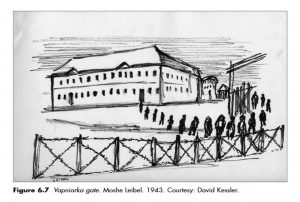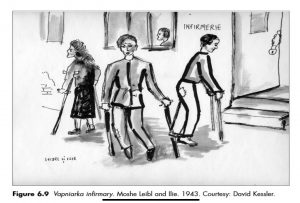Elsewhere on this website, the attempts by Romanian officials to exterminate the prisoners of Vapniarka have been well documented. However, often missing are the acts of resistance organized by Jewish leaders within the camp, and carried out by the broader community. I envision these acts as three separate, yet simultaneous, acts of resistance and fights for survival.
*****
ACT I: Artistic Engagement within Vapniarka
In his memoir describing his imprisonment in Vapniarka, Dr. David Kessler, as retold by Dirk Enneking, recalled that each prisoner in Vapniarka was required to have an occupation: “Each position had the right man, the most reliable, the most useful. Everyone had something to do, work outside the camp, camp duty, workshop, restaurant, wood distribution, parasite control and art work. Musical composition and practice of songs, but no idleness” (Enneking 2015, 4). Kessler explained this organizational scheme as essential for the survival of Vapniarka’s prisoners. Essentially, he argued that giving every prisoner a job, in some regard, protected their mental health, “because if one is demoralized, this demoralizes those around him as well” (Kessler in Enneking 2015, 4). Continuing Kessler’s argument, it seemed that involving each prisoner in the day-to-day management of the camp motivated them to fight for survival.
Including artistic endeavors in the management of the camp had a perhaps unexpected result: the documentation of life within Vapniarka, in the murderous and the mundane. Some examples are shown below.
Nathan Simon’s Wapniarca, which has been analyzed elsewhere (Simon in Shapiro 2013, 123):
Aurel Marculescu’s 1943 Vapniarka Building, which illustrates the spacial orientation of the camp, and portrays prisoners both performing manual labor and suffering from neurolathyrism (Marculescu in Hirsch and Spitzer 2006, 147):
Gabriel Cohen’s drawings of life in Vapniarka, which depict everyday tasks and the cruelty of Vapniarka’s guards (Cohen in Shapiro 2013, 129-30):
Moshe Leibl’s 1943 drawings, of which two were created in conjunction with Ilie, portray everything from the inhumane suffering in Vapniarka to other interpretations of the camp’s spacial organization (Leibl in Hirsch and Spitzer 2006, 146-9):
The creation of these pieces of art, amongst many others, served to cultivate the artistic talents of Vapniarka’s prisoners, and prevent their demoralization. However, as mentioned above, they also enable society to remember Vapniarka, even decades later. They documented the physical space of the camp. They documented the camp life, from manual labor to the cruelty of the Romanian guards. And perhaps most importantly, they documented the brutal effects of neurolathyrism and the forced consumption of Lathyrus Sativus. In an era when Antonescu was eager to “cleanse the Romanian Nation” of Jews, creating an artistic record of Romanian atrocities was an act of eternal resistance against the Romanian Holocaust (Antonescu in Braham 1998, 21).
*****
ACT II: Religious Observance in Vapniarka
The creation of art preserved evidence of Romanian atrocities while empowering the contingent of Jewish artists imprisoned in Vapniarka. However, the celebration of religious ceremonies, although not seemingly prohibited by Vapniarka’s commandants, served as another method of preventing the demoralization of the prisoners. In his post-war testimony about his imprisonment in Vapniarka, Dr. Ihiel Benditer recalled the occurrence of multiple religious ceremonies. In 1943, he recalled, “a group of youngsters prepared a Purim-spiel,” retelling the story of the prevention of a massacre of Jews in the Babylonian era (Benditer 1995). Perhaps more importantly, he also recalled a Passover Seder being held, with wide observance from Jews across the camp: “Even the non-believers, who thought of themselves as free thinkers, did not eat bread, but limited themselves to a few potatoes….Passover in Vapniarca had the meaning of common solidarity” (Benditer 1995). The religious observance of holidays, but Passover and Purim in particular, seemed to be important to preserving the prisoners’ psyche. Both Passover and Purim have themes of escaping oppression into freedom: Passover commemorates the Israelites escaping Egyptian Slavery, and Purim commemorates the prevention of a genocide of the Babylonian Jewish community (Benditer 1995). As such, religious observance was an act of communal resistance. In the face of the genocide, the Jews of Vapniarka gathered to protect their identity, even as the Romanians worked to erase it. This too, was resistance.
*****
ACT III: Hunger Strike
As the population of prisoners afflicted by neurolathyrism continued to grow, Dr. Arthur Kessler, a Jewish physician interned in Vapniarka, appealed to then-camp commander Buradescu to remove the poisonous Lathyrus Sativus from the prisoners’ diets, and to accumulate medical supplies and treatment for the prisoners (Kessler in Enneking 2015, 6). They were met with explicit disinterest: “How do you know that we are interested in keeping you alive?” (Kessler in Enneking 2015, 6).
The hunger strike that followed, and its eventual success, is detailed in the narrative. However, I want to return to the Passover celebration mentioned above. Dr. Benditer recalled “even though it was our only food, we refused to eat the toxic pea cattle fodder. There were not just a few inmates who went on strike; we all did…just like any solidarity front would do” (Benditer 1995). The strike was like a Passover fast: as Jews avoid leavened bread during Passover, the Jews of Vapniarka avoided L. Sativus, bringing the epidemic to a halt. But crucially, they worked as a community, preserving not just their traditions, but, at least temporarily, their lives.
*****
The prisoners in Vapniarka all resisted Romanian cruelty in various, yet important, ways. Many worked physical jobs crucial to keeping the camp running (Enneking 2015, 4). Artists worked to preserve a record of Vapniarka, to boost their own morale, and to prevent the disappearance of the camp’s atrocities from our historical memory. Religious ceremonies, even for the secular, reminded the prisoners of their identities, of freedom, and of their will to survive. Of course, the hunger strike became the collective physical manifestation of this resistance. Through these forms of resistance, each prisoner joined a dramatic fight for life, one that ought to be eternally remembered, and honored.

